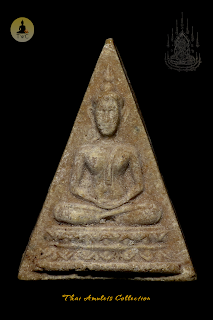History and Details of
Phra Phuttha Pang Samathi Pim Samlian Pim Yai
Wat Prasat, B.E. 2506 (1963)
Consecrated by: Luang Phor Kuay, Wat Kositaram
1. Overview
-
Amulet Name: Phra Phuttha Pang Samathi
-
Pim (Mould): Pim Samlian Pim Yai (Large Type)
-
Temple of Origin: Wat Prasat, Bangkok
-
Year of Production: B.E. 2506 (1963)
-
Primary Material: Nur Phong Namon (Holy Powder mixed with holy water residue)
-
Consecrated By: Luang Phor Kuay of Wat Kositaram, Chainat Province
2. Background and Purpose of Creation
The amulet was created as part of a grand sacred initiative led by Wat Prasat to produce a series of spiritually potent Buddha images. The project aimed to preserve ancient Buddhist artistry while invoking deep protective and meditative power through powerful consecration rituals. The sacred powder was mixed with holy remnants from earlier Buddhist ceremonies and sacred components from temples throughout Thailand.
3. Design and Physical Characteristics
-
Front Design:
-
Features the Buddha in Pang Samathi (Meditation posture), seated cross-legged in the Dhyana mudra, symbolizing inner stillness and deep concentration.
-
Expressive facial features and flowing robe detailing indicate classic early Rattanakosin artistic influence.
-
-
Back Design:
-
Some variants are plain, while others are impressed with yantra inscriptions or temple markings.
-
-
Material Texture:
-
Smooth but dense sacred powder body, slightly grainy due to Phong Namon (residual holy water sediment mixed with pollen, herbs, and ground amulets).
-
4. Consecration Ceremony
-
Location: Wat Prasat, Bangkok
-
Main Presiding Monk: Luang Phor Kuay (Wat Kositaram)
-
Other Participating Monks: Likely included senior monks from Bangkok and surrounding provinces.
-
Ritual Details:
-
Multi-day Phuttha Abhiseka ceremony with intensive chanting, protective spell recitations, and invocation of sacred energies.
-
Luang Phor Kuay was personally invited due to his revered status as a master in mantra recitation, metta meditation, and consecration of powerful amulets.
-
5. Sacred Composition (Nur Phong Namon)
The holy powder mixture (Phong Namon) used to create this amulet included:
-
Residual sacred sediment from earlier Phra Somdej creations
-
Pulverized old votive tablets from renowned temples
-
Pollens and dried herbs (Wan Saneh Jan, Wan Dok Tong, etc.)
-
Earth from sacred temple sites and cremation grounds
-
Namon (residue of blessed water from previous rituals)
6. Spiritual Beliefs and Benefits
The amulet is widely respected for its meditative and protective power. It is believed to:
-
Enhance meditation and mental clarity
-
Shield against misfortune, danger, and bad influences
-
Promote emotional stability and spiritual focus
-
Support metta (loving-kindness), attracting goodwill from others
-
Facilitate personal success and peace of mind
It is particularly favored by practitioners of Vipassana and Thai-Chinese devotees who value inner serenity and resilience.
7. Rarity and Collector Value
-
Distribution: Limited temple release during 1963; most were reserved for close devotees or donors of the temple project.
-
Verification: Some pieces are documented and certified by Thai amulet authenticators, including DD-Pra.
-
Market Demand: Highly collectible among devotees of LP Kuay and collectors of post-war era Bangkok amulets.
8. Legacy of Luang Phor Kuay
Luang Phor Kuay (1905–1979) was one of the most highly venerated monks of the 20th century, known for his mastery in Pali scriptures, traditional healing, and powerful mantra consecration. His involvement in the consecration of any amulet, especially in the mid-20th century, is considered a seal of spiritual integrity and potency.
Summary:
The Phra Phuttha Pang Samathi Pim Samlian Pim Yai, BE2506 Wat Prasat, consecrated by Luang Phor Kuay, is a deeply spiritual and historically rich amulet known for its meditative properties, sacred composition, and protective powers. Its elegant design and powerful blessing ceremony make it a valuable addition to any collector or practitioner seeking inner peace, mindfulness, and protective strength.

%20BE2506.png)


